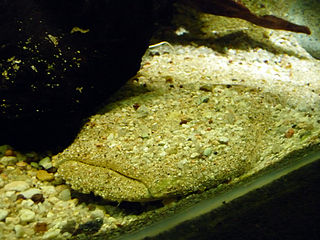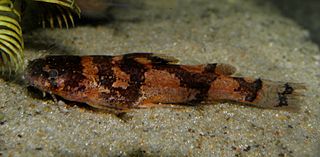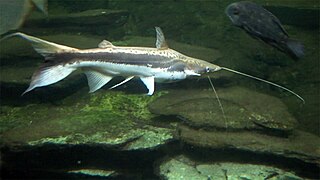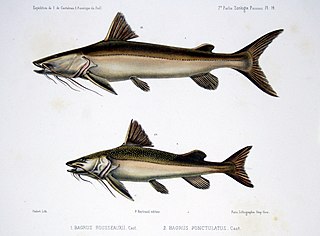Vandellia is a genus of catfishes native to South America. The species in this genus are the most well-known of the parasitic catfishes also known as candiru, known for their alleged habit of entering the human urethra.

Pseudoplatystoma is a genus of several South American catfish species of family Pimelodidae. The species are known by a number of different common names. They typically inhabit major rivers where they prefer the main channels and tend to stay at maximum depth, but some species can also be seen in lakes, flooded forests, and other freshwater habitats. They have robust bodies, and are important food fish. Recently, their population size has been on the drastic decline due to a variety of factors including overfishing and habitat destruction due to the construction of hydroelectric dams.

The Pimelodidae, commonly known as the long-whiskered catfishes, are a family of catfishes.

The Pseudopimelodidae are a small family of catfishes known as the bumblebee catfishes or dwarf marbled catfishes. Some of these fish are popular aquarium fish.

Microglanis is a genus of fish in the family Pseudopimelodidae native to South America. This genus has the widest distribution within its family, with species ranging from the Guianas to Venezuela; western slope of the Andes in Ecuador and Peru to the Río de La Plata basin in Argentina. They occur eastward to the Orinoco and Amazon basins. It is also present in the eastern coastal rivers of Brazil.
Microglanis leptostriatus is a species of catfish belonging to the family Pseudopimelodidae. It appears to be entirely restricted to the middle and upper basin of the São Francisco River in Brazil.

Sorubim is a small genus of long-whiskered catfish native to tropical South America. A number of characteristics allows the differentiation of each species in the genus. Sorubim species are important food fish in South America and are highly significant to fisheries of some areas; however, harvests of these fish are not identified as much as other, more popular food fishes such as Colossoma, Arapaima, and Brachyplatystoma. Some species of this family are popular aquarium fish.

Brachyplatystoma is a genus of catfish from the family Pimelodidae. As the occasionally used common name goliath catfishes indicates, this genus includes some of the largest species of catfish, including the piraíba, B. filamentosum, which reaches up to the region of 3.6 metres (12 ft) in length. Brachyplatystoma are found in the Amazon and Orinoco basins, and other tropical freshwater and brackish habitats in South America. Some species are migratory. These fish are important as food fish and, to some extent, aquarium fish.

Steindachneridion is a genus of South American pimelodid catfish.

Batasio is a genus of catfish of the family Bagridae. These small fish are found in fast-flowing hillstreams throughout South and mainland Southeast Asia.
Cruciglanis is a genus of catfish of the family Pseudopimelodidae. It contains a single recognized species, Cruciglanis pacifici.

Leiarius is a genus of long-whiskered catfishes native to South America. Most of the genus' species are found in the aquarium hobby as ornamental fish.

Bagarius is an Asian genus of catfishes of the family Sisoridae. It includes five to six extant species and potentially one extinct fossil species, B. gigas.

Sisor is a genus of catfishes native to Asia.
Pseudexostoma is a genus of fish in the family Sisoridae endemic to China. These species are restricted to the upper Salween and one upper branch of the Irrawaddy in China. P. brachysoma is known only from the middle and lower Nujiang River. P. yunnanensis is only known from the upper Dayinjiang. These rivers were once connected, but are now separated. Also, the environment and temperature of the Nujiang River became greatly different between the northern and southern areas, leading to speciation.
Parakysis is a genus of catfishes of the family Akysidae. It includes six species.
Breitensteinia is a genus of catfishes of the family Akysidae. It includes three species.
The Somalia catfish is a species of catfish in the family Bagridae. The Somalia catfish is native to the Jubba River in Somalia.

Bryconops melanurus, sometimes called the tail-light tetra, is a small species of freshwater fish from South America that primarily preys on insects. It lives in small schools and is an active swimmer, which means that it requires open space in its habitat. Nonetheless, it does not demonstrate a strong preference for any one biotope within its native range.
Bryconops allisoni is a species of freshwater fish known from the rivers of Brazil. It is a recent addition to the genus (2019), currently considered a member incertae sedis. Its name honors Antonio Machado-Allison, an ichthyologist responsible for a great deal of work on the genus Bryconops.












